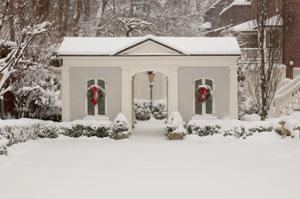
Real estate companies, insurance firms and home appraisers hire freelance photographers, who take pictures of houses to earn money and build their photography portfolio.
Learning How to Take Pictures of Houses to Earn Money
First things first; building a reputation and a client base depends upon your portfolio and your ability to market your work.
Portfolio
Assembling a portfolio is essential in order to begin your journey as a photographer. A portfolio can be presented in hard copy form with prints or digitally, via a website. Your portfolio should have about 15-20 good images of homes, including at least one complete set of both the interior and exterior of a home. This shows your ability to handle different environments and lighting situations, which are common with real estate photography.
Equipment
Most real estate photographers will be expected to supply their own equipment. This includes cameras, lenses and accessories, such as tripods and flashes.
- Cameras: Real estate photography calls for versatility, which should be reflected in your camera body. Choose a camera which performs well in low light situations. Your camera will also need to be durable, since exterior photographs may need to be taken in a variety of weather conditions. Ideally, an SLR camera body with changeable lenses is the best tool for home photographs, but a high-end point-and-shoot camera with multiple settings can perform very well too.
- Lenses: If you are using a SLR camera, you have the advantage of being able to change lenses. If you are going to take pictures of houses to earn money, then you will need to be prepared for a number of situations. Wide angle lenses are great for interior photographs and for wide exterior shots. These can be either a fixed focal length or a zoom lens. Choose high quality lenses with wide aperture settings, since this gives you creative control over the image and over your lighting situation.
- Flash: Most cameras have a built-in, pop up flash, but this can be inadequate when it comes to real estate photography. You will need a separate flash unit, preferably one with a head that adjusts and swivels so that light can be bounced into darker corners. This can help you to minimize unflattering shadows.
- Tripod: This piece of equipment is often overlooked. A tripod can help in many situations. This helps to avoid camera shake at slow shutter speeds for photographs in low light settings. It also ensures that you are holding the camera level, minimizing the effects of convergence - a type of distortion which can ruin a real estate photograph.
Marketing Tips
Working in the real estate photography field isn't restricted to just realtors. Appraisers and insurance specialists also need photographers who understand the challenges of photographing houses.
Advertising
Getting your name to potential clients is a task which requires constant attention. Not only do your potential clients need to see your name, they need to remember it when they are looking for a real estate photographer.
Marketing can be a major business expense, so it's important to target your potential clients. Placing ads in local papers or online can help you attract both real estate sales companies, as well as individual and private sellers who need your services. Start by using free options, then as you discover your target market, you will be able to choose better places to display print or other types of ads.
Contacts
In-person advertising holds the most impact, so make a point to visit local companies that may need a real estate photographer. This includes:
- Real estate agents
- Insurance companies
- Real estate appraisers
- Property management firms
- Rental companies
When visiting, leave a business card and make sure your portfolio is readily accessible.







